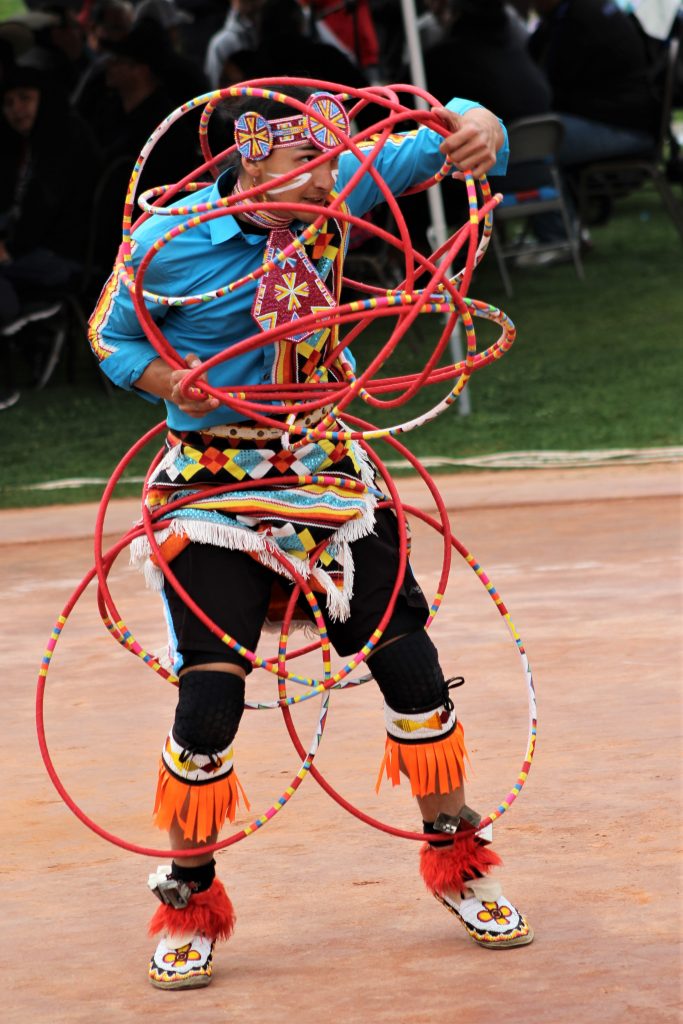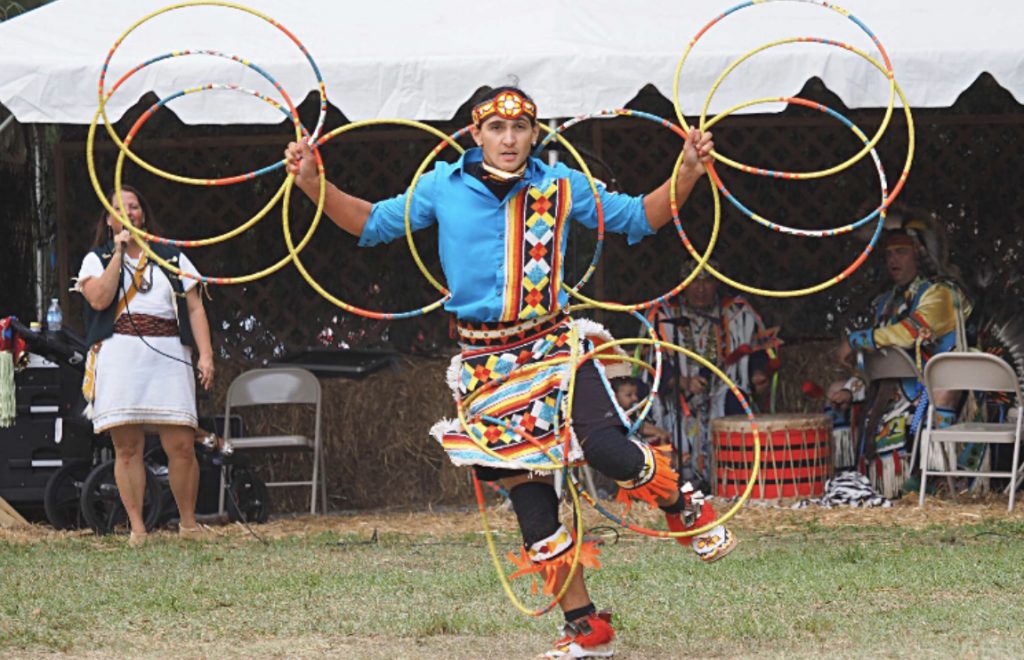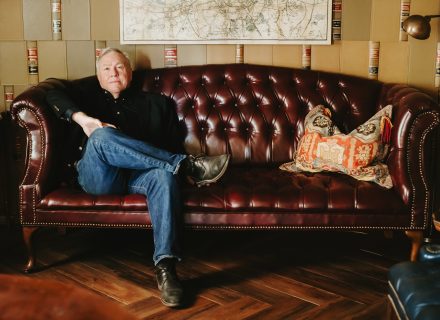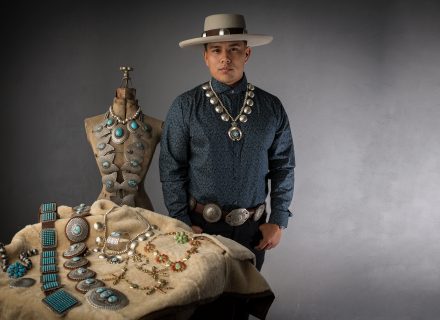As he prepares to defend his title, world champion dancer Cody Boettner reflects on athleticism, artistry, and the circle of life.
Growing up in Daytona Beach, Florida, Cody Boettner didn't just head for the beach or the racetrack. He headed for the hoops. The 28-year-old Muscogee Creek athlete has been hoop dancing since he was a kid. His more than two decades of practicing brought him to national attention last February when he captured the top prize at the 2019 Heard Museum World Championship Hoop Dance Contest in Phoenix.
For Boettner, hoop dancing is many things: athletic competition, art, cultural ambassadorship, and a strong symbol with a meaning that’s greater than the sum of its parts: “I think it means that we are all connected in some way in this world,” he says. “It doesn’t matter where you come from. We are all part of that circle. Hoop dancing gives us understanding and it reminds us that we are not the only living things on this planet.We are part of something much grander in scale, and we should take care of this place where we live, because one day the earth may decide to shake us off and be done with the abuse.”
Boettner will be defending his title when he competes February 8 – 9 at the Heard against other top American Indian and Canadian First Nations hoop dancers. We talked with him about his championship feat and what it takes to dance with a dozen- plus hoops symbolizing the never-ending circle of life.
Cowboys & Indians: What’s the place of hoop-dancing in Native American culture?
Cody Boettner: Hoop dancing stemmed from the Southwest and started off as a ceremonial dance. Today it represents many things and stories that have been passed down. It’s a dance of healing and a prayer for the earth. It’s a celebration of the circle of life. The dancers mix athleticism and artistry to tell stories of the earth, sun, and moon, and everything that lives in between, from the biggest living creatures to the smallest. Everything takes and receives from one another. Even we humans gather from the earth what we need to survive until we eventually die and give our bodies back to the earth. The hoops represent our emotions. They represent our experiences and the different people who have both come into and left our lives. The hoops weave together to form designs you might find in nature. They form animals and insects. The purpose of hoop dancing today is all of these things. It shows our connection to the circle of life.
C&I: Tell us about the dance you performed that won the championship at the Heard. How long did you work on the choreography, and what does the choreography mean?
Boettner: The routine I did at the Heard is one that I started working on at the end of the last world championship contest. The new moves and ideas that come into my head are slowly implemented into my routine while other moves might be taken out. Then I’ll practice it all year — that way, by the next contest it’s a solid and fluid dance. The designs and moves I make I think tell a story of the earth, sun, and moon, as well as the living organisms that live in between. Some moves or designs are easily recognizable, like the lizard or the eagle, but others might not be easy to identify. It’s up to the viewer’s imagination at that point. If you have a good imagination, you will be able to see many things.
C&I: What about the music you performed to?
Boettner: The music is all powwow songs and was done by the two host drums, Mandaree and Cozad. The drum groups represent Northern and Southern styles: Mandaree Singers led by Sidrick Baker Sr. (Mandan, Hidasta, Arikara nations), and Cozad led by Kenneth Cozad Jr. (Kiowa, Comanche). They produce all their own songs. Some songs have chants and some have actual words in certain languages. For the final round, you are allowed to have your own singer perform whatever song you want, but I didn’t have a singer with me, so I asked Mandaree Singers to play something fast and upbeat for me.
C&I: What was it like to win the 2019 championship?
Boettner: I like dancing to faster-paced songs, and so during my first round, I requested a certain speed from the Mandaree Singers. I clapped my hands to the speed I wanted, to show them how fast to go. Then when I got out there, I remember it being a lot faster than I requested. At first I was freaking out a little bit because I wasn’t sure if I could hold that pace all the way through, but I collected myself and thought, This is why I conditioned all those months. And then I just went for it.
I remember thinking how in the past I was always so nervous. And my nerves would get the best of me. I’d always do pretty good, but I’d also make a mistake, like maybe I dropped a hoop here or there, or maybe my world formation didn’t stay together. So this time ... I tried to tell myself to have fun, let my body take over, let the muscle memory do its thing, and just dance to the music that was being played. Halfway through my first round, I remember looking back and seeing lots of other hoop dancers watching me from the back of the judging tent, and I immediately felt a surge of confidence rush through me, because I knew that getting them to stop whatever they were doing and watch me was a pretty big deal and I must have been putting on a pretty good show.
At previous hoop dance contests at the Heard Museum, I would make it to the Top 10 (2nd round), which is a pretty big accomplishment in itself, but I would never make it to the final round or the Top 6, so going into [the 2019 competition] I was thinking that it would be pretty cool to get into the Top 6. When the first-round scores came out, I saw my name with the letter “1” next to it and the most points I have ever accumulated in the contest from previous years, and I remember thinking, I have a chance to make the Top 6 this year.
Going into the final round, I was completely calm because I had already made it further than I ever had in the past and I was pretty happy with that. So my final dance was probably one of the best performances I’ve ever done. During the awards, when they announced 2nd place, and I realized that I was the only one left, and there was only one place left, it was unbelievable. I started thinking of my parents, who were in the crowd watching, and all my friends and family back home. It was a surreal experi- ence to walk out onto the dance ground as world champion and be congratulated by other hoop dancers, judges, and head staff, many of whom are also former world champions. Many of the hoop dancers I shook hands with are people who I have looked up to.
C&I: You mentioned being nervous. How do you handle nerves when you perform?
Boettner: The first time I came to the Heard, I remember getting so nervous, and it was because I sat out there and watched everyone perform. I literally psyched myself out and doubted myself. So the past few years, what I’ve been doing is just sitting in the back room with all the other hoop dancers and just chilling out. Many of the other hoop dancers will be back there and I’ll talk about anything else rather than hoop dancing, like where we’ve been this summer, or the crazy animals in Florida. Every once in a while, I’ll get up and practice or stretch out, maybe even go outside and watch a dancer or two perform. But I just try to make my environment real comfortable and inviting so that I’m as relaxed as possible. Right before it’s my turn, I’ll grab my hoops and just remember that the audience came to see what I put together in my routine, so I try to think of it as a show rather than a competition.
C&I: What kinds of skills are required to dance well?
Boettner: Hoop dancers are judged in five categories: precision, rhythm and timing, showmanship, creativity, and speed. Dancers must pass through every hoop they bring out onto the dance arena at least once, and hoops cannot drop to the ground unintentionally. On top of the physical aspects of hoop dancing, there’s also intellectual aspects you have to know. You have to know the songs and how and why these songs are sung that you’re dancing to. How can you expect to dance good if you don’t know about the music you’re dancing to? There’s also these personal questions that we as Native dancers need to address to ourselves. Do you know why you’re dancing and who you’re dancing for? The history of this dance? These are all things that we need to know the answers to. Knowing these things gives you a reason to dance. You’re honoring those who maybe physically can’t dance, and those who have been here in the past.
C&I: What else are you thinking and feeling when you dance?
Boettner: Every once in a while, the drum singing for me will put out a really good song. You can definitely tell that they are putting out energy. That, along with the crowd’s energy, makes me want to dance hard. I think when you feel something like that, you are at ease. You never get tired. Muscle memory takes over for some parts of your routine and on-the-spot maneuvers come out in other parts. You really are in the moment, and the feeling is unlike any other. Some of the best hoop dances I’ve ever done were times when I was having fun with the routine.
C&I: How do you stay in hoop-dancing shape?
Boettner: Lots of running and conditioning. It doesn’t hurt that Florida has great year-round weather, so it’s always a good day to get active, whether that means going for a bike ride or getting in the water. I think flexibility is also important, so I do lots of stretches. Going to powwows and dancing also helps, not only with conditioning, but it allows you to practice your dancing, which of course is the most important aspect.
C&I: What outfits and gear do you use, and what’s the significance?
Boettner: Hoop dancing originated in the Southwest part of the United States, but the dance is now shared by all tribes, like most of the modern powwow dances. Because I’m from the Southeast, I wanted to have an outfit that represents the tribes that live there, such as the Seminole and my tribe, the Creeks. The turquoise aprons and shirt I have are made with Seminole patchwork. Patchwork is shared by most Southeastern tribes, and it takes many hours of work to sew together.
C&I: What are the hoops made of ? Do you make your own?
Boettner: I do make my own hoops. They are made with PEX tubing with tape designs on the outside. The PEX tubing is pretty durable and flexible. It keeps its shape and lasts for a long time. Originally, tribes would have used the willow trees to make the hoops. Some hoop dancers still use wooden hoops today.
C&I: This is such a precise and athletic art. How old were you when you started and how did you learn?
Boettner: I was about 4 or 5 when I started. Some of my friends growing up were hoop dancers—Amanda Ironstar and her brothers, Otter Oliver and Turtle Big Mountain, taught me how to dance and taught me some of my first hoop designs. They had learned from their family members like their mom, Katrina Fisher. I would see Otter and Turtle a lot at the local powwows. Our families did a lot of shows together, and we would work on moves every time we saw each other. Later on, Otter would always tell me to go compete at the Heard, but I never thought I stood a chance. My father, Jim Sawgrass, who does educational and living-history presentations, made me my first set of hoops. Next thing I knew, I was dancing for his shows.”
C&I: Besides those who taught you, who are some other hoop dancers that inspire you?
Boettner: Gosh, there are so many hoop dancers that have inspired me, it’s hard to name them all. I met Lowery Begay at one point in my childhood. Seeing him dance live really inspired my creativity. He’s always been a big supporter of mine. It was actually Richard Bird who came up to me and told me, “You need to go out there and compete at the Heard.” He sat me down and gave me a scoring sheet that the judges used and broke down how well I did in each of those categories already. He told me that I am good enough and really pushed my confidence to finally go.
When I went to the Heard for the first time, I had no friends there at first, but everyone was so inviting and friendly and willing to teach you stuff. I learned so much after my first trip. Hoop dancers who kind of took me in and gave me lots of advice include Patrick Willie and his family, the Sinquah family, the Jensen family, Brian Hammill, James Jones, Joseph Secody, Dallas Arcand, the Duncans, the Goedels. They all have inspired me and given me advice at one point.
C&I: What has hoop dancing given you?
Boettner: Through hoop dancing and performing with my family I have been able to see some pretty amazing places, meet all kinds of great people, make friends, and eat some of the most amazing foods. I think it’s helped open my mind to the world in a certain way and given me appreciation for the many things we have. ... I think being able to turn what you love — for me that’s dancing — into a career is the lifelong goal for everyone.
C&I: What do you hope people take away from seeing you dance?
Boettner: I hope to inspire people and bring a positive message—that we are all part of a giant living, breathing system of life. This unique world that we live in is precious. Life is precious and we shouldn’t take it for granted. The world is not only our home. We share it with trillions of other organisms, all taking and giving to each other. We are a part of that circle and we should help to take care of it. There is a balance to everything within it.
I feel immediate pressure as the current champion, not necessarily to perform at a certain caliber, but more to send good messages and feelings to people when I dance. There are many dancers before me who have been here in this position, and they have created an amazing foundation that I’m fortunate to be a part of. I know that I’m representing them as well as all Natives who have made hoop dancing a part of their life. I want to make sure I represent in a positive way.
C&I: What message would you like to leave people with?
Boettner: We have many things, activities, people in our lives that make up our identity as a person. We must figure out how to balance these things that make up our world. Sometimes, something will happen [that causes] one of these things to disappear. A person leaves your life for whatever reason. Something changes, and it throws everything else off balance. We can get back up. The human mind and body are strong. We always have the power, the world, in our hands. And with this message, we can do anything we set our minds to.
The 30th Annual Heard Museum World Championship Hoop Dance Contest kicks off Friday, February 7, 6 to 10 p.m. The contest runs Saturday, February 8 – Sunday, February 9, 9 a.m. to 5 p.m. Gates open at 8:45 a.m. with the grand entry at 9:30 a.m. Watch the event live streamed on facebook.com/HeardMuseum/. Find out more at heard.org. Follow Cody Boettner on Facebook, Twitter, and Instagram.
Photography: Courtesy of Cody Boettner, Joanna Proffitt Photography
From our January 2020 issue.



















